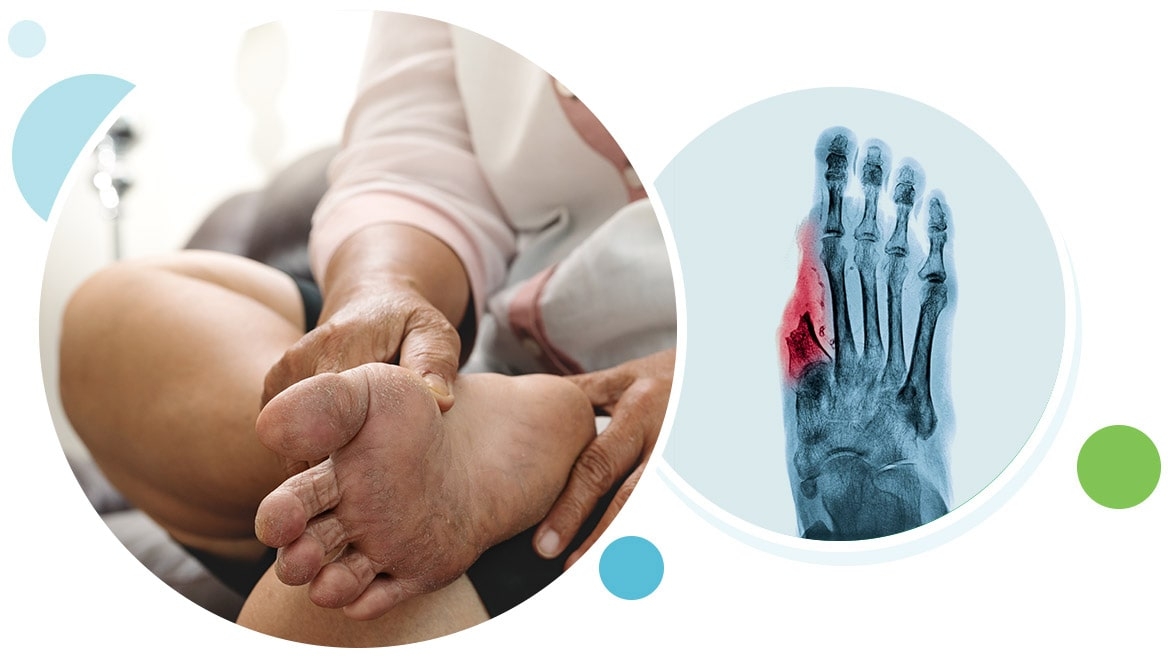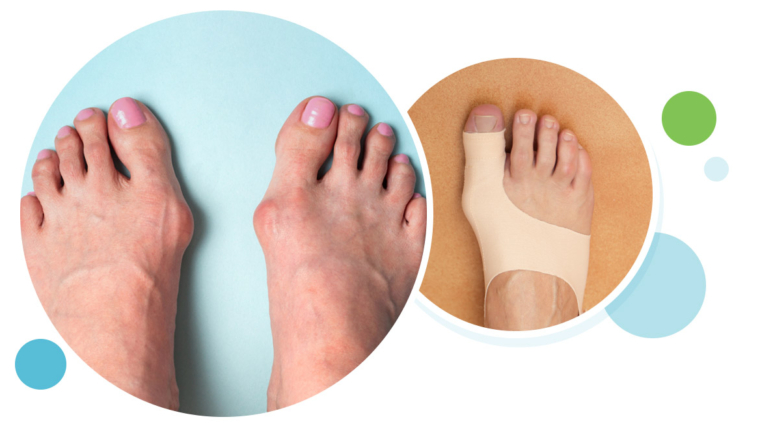Signs of Diabetic Foot Problems
With diabetes, there are a lot of foot problems that can arise due to the nature of the disease and its systemic effects. Especially when it comes to the foot and ankle, it is important to constantly be looking out for signs of diabetic progression.
- Changes in skin color
- Changes in skin temperature
- Swelling in the foot or ankle
- Pain in the legs
- Open sores on the feet that are slow to heal or are draining
- Ingrown toenails or toenails infected with fungus
- Corns or calluses
- Dry cracks in the skin, especially around the heel
- Foot odor that is unusual or won’t go away
Complications of Diabetic Foot Problems
Skin and bone infections from ulcerations. A small cut or wound can lead to infections. Nerve and blood vessel damage, along immune system problems, make them more likely. Most infections happen in wounds previously treated with antibiotics. Infections can be treated with antibiotics. Severe cases may require treatment in a hospital.
Abscess. Sometimes infections eat into bones or tissue and create a pocket of pus called an abscess. The common treatment is to drain the abscess. It may require removal of some bone or tissue, but newer methods, like oxygen therapy, are less invasive.
Gangrene. Diabetes affects the blood vessels that supply your fingers and toes. When blood flow is cut off, tissue can die. Treatment is usually oxygen therapy or surgery to remove the affected area.
Deformities. Nerve damage can weaken the muscles in your feet and lead to problems like hammertoes, claw feet, prominent metatarsal heads (ends of the bones below your toes), and pes cavus, or a high arch that won’t flatten when you put weight on it.
Charcot foot. Diabetes can weaken the bones in your foot so much that they break. Nerve damage can lessen sensation and prevent you from realizing it. You keep walking on broken bones and your foot will change shape. It might look like your arch has collapsed into a rocker shape.
Amputation. Problems with blood flow and nerves make it more likely for people with diabetes to get a foot injury and not realize it until infection sets in. When an infection can’t be healed, creates an abscess, or if low blood flow leads to gangrene, amputation is often the best treatment.
Diabetic peripheral neuropathy
Diabetic neuropathy is nerve damage caused by diabetes. The type of neuropathy occurring in the arms, hands, legs and feet is known as diabetic peripheral neuropathy. Diabetic peripheral neuropathy is different from peripheral arterial disease (poor circulation), which affects the blood vessels rather than the nerves. Three different groups of nerves can be affected by diabetic neuropathy:
- Sensory nerves, which enable people to feel pain, temperature, and other sensations.
- Motor nerves, which control the muscles and give them their strength and tone.
- Autonomic nerves, which allow the body to perform certain involuntary functions, such as sweating.
Diabetic peripheral neuropathy doesn’t emerge overnight-instead, it usually develops slowly and worsens over time. Some patients have this condition long before they are diagnosed with diabetes. Having diabetes for several years may increase the likelihood of having diabetic neuropathy. The loss of sensation and other problems associated with nerve damage make a patient prone to developing skin ulcers (open sores) that can become infected and may not heal. This serious complication of diabetes can lead to loss of a foot, a leg, or even a life.
Signs and Symptoms
Depending on the type(s) of nerves involved, one or more signs and symptoms may be present in diabetic peripheral neuropathy. For sensory neuropathy:
For sensory neuropathy:
- Numbness or tingling in the feet.
- Motor nerves, which control the muscles and give them their strength and tone.
For motor neuropathy:
- Muscle weakness and loss of muscle tone in the feet and lower legs
- Loss of balance
- Changes in foot shape that can lead to areas of increased pressure
For autonomic neuropathy:
- Dry feet
- Cracked skin
What Causes Diabetic Peripheral Neuropathy?
The nerve damage that characterizes diabetic peripheral neuropathy is more common in patients with poorly managed diabetes. However, even diabetic patients who have excellent blood sugar (glucose) control can develop diabetic neuropathy. There are several theories as to why this occurs, including the possibilities that high blood glucose or constricted blood vessels produce damage to the nerves. As diabetic peripheral neuropathy progresses, various nerves are affected-and these damaged nerves can cause problems that encourage development of ulcers. For example:
- Deformities (such as bunions or hammertoes) resulting from motor neuropathy may cause shoes to rub against toes, creating a sore. The numbness caused by sensory neuropathy can make the patient unaware that this is happening.
- Because of numbness, a patient may not realize that he or she has stepped on a small object and cut the skin.
- Cracked skin caused by autonomic neuropathy, combined with sensory neuropathy’s numbness and problems associated with motor neuropathy can lead to developing a sore.
What is a Diabetic Foot Ulcer?
A diabetic foot ulcer is an open sore or wound that occurs in approximately 15 percent of patients with diabetes and is commonly located on the bottom of the foot. Of those who develop a foot ulcer, 6 percent will be hospitalized due to infection or other ulcer-related complication.
Diabetes is the leading cause of non-traumatic lower extremity amputations in the United States, and approximately 14-24 percent of patients with diabetes who develop a foot ulcer will require an amputation. Foot ulceration precedes 85 percent of diabetes-related amputations. Research has shown, however, that development of a foot ulcer is preventable.
Causes
- Anyone who has diabetes can develop a foot ulcer. Native Americans, African Americans, Hispanics, and older men are more likely to develop ulcers. People who use insulin are at higher risk of developing a foot ulcer, as are patients with diabetes-related kidney, eye, and heart disease. Being overweight and using alcohol and tobacco also play a role in the development of foot ulcers.
- Ulcers form due to a combination of factors, such as lack of feeling in the foot, poor circulation, foot deformities, irritation (such as friction or pressure), and trauma, as well as duration of diabetes. Patients who have diabetes for many years can develop neuropathy, a reduced or complete lack of ability to feel pain in the feet due to nerve damage caused by elevated blood glucose levels over time. The nerve damage often can occur without pain, and one may not even be aware of the problem. Your podiatrist can test feet for neuropathy with a simple, painless tool called a monofilament.
- Vascular disease can complicate a foot ulcer, reducing the body’s ability to heal and increasing the risk for an infection. Elevations in blood glucose can reduce the body’s ability to fight off a potential infection and also slow healing.
Symptoms
Because many people who develop foot ulcers have lost the ability to feel pain, pain is not a common symptom. Many times, the first thing you may notice is some drainage on your socks. Redness and swelling may also be associated with the ulceration and, if it has progressed significantly, odor may be present.
What can your doctor do at Northstate Foot & Ankle Specialists?
A major goal of the foot and ankle surgeon is to prevent amputation. There are many new surgical techniques available to save feet and legs, including joint reconstruction and wound healing technologies. Getting regular foot checkups and seeking immediate help when you notice something can keep small problems from worsening. Your foot and ankle surgeon works together with other health care providers to prevent and treat complications from diabetes. Services to assist in such include:
- Smart-LEDA
- ABI/TBI vascular testing
- Wound care
- MRI for possible complications
- Physical therapy with gait training assistance
- Diabetic shoe gear fitting and dispensing
- Routine care and education
- Charcot reconstruction
- Amputation
When is Amputation Necessary?
The goals of treatment of diabetic foot problems are not only to save the life and limb, but also to get the patient healed and moving about as soon as possible. If vascular surgery cannot improve blood flow and podiatric surgery cannot restore function, amputation may be the only solution that gets the patient walking again. Amputation may involve one or two toes, part of the foot, or part of the leg. It is selected on the basis of the patient’s condition and level of predicted healing. A return to normal life is especially possible today because of advances in prosthetics.
Care guidelines:
Diabetes can be dangerous to your feet—even a small cut can produce serious consequences. Diabetes may cause nerve damage that takes away the feeling in your feet. Diabetes may also reduce blood flow to the feet, making it harder to heal an injury or resist infection. Because of these problems, you may not notice a foreign object in your shoe. As a result you could develop a blister or a sore. This could lead to an infection or a nonhealing wound that could put you at risk for an amputation.
To avoid serious foot problems that could result in losing a toe, foot or leg, follow these guidelines.
Inspect your feet daily. Check for cuts, blisters, redness, swelling or nail problems. Use a magnifying hand mirror to look at the bottom of your feet. Call your doctor if you notice anything.
Bathe feet in lukewarm, never hot, water. Keep your feet clean by washing them daily. Use only lukewarm water—the temperature you would use on a newborn baby.
Be gentle when bathing your feet. Wash them using a soft washcloth or sponge. Dry by blotting or patting, and carefully dry between the toes.
Moisturize your feet but not between your toes. Use a moisturizer daily to keep dry skin from itching or cracking. But DON’T moisturize between the toes—that could encourage a fungal infection.
Cut nails carefully. Cut them straight across and file the edges. Don’t cut nails too short, as this could lead to ingrown toenails. If you have concerns about your nails, consult your doctor.
Never treat corns or calluses yourself. No “bathroom surgery” or medicated pads. Visit your doctor for appropriate treatment.
Wear clean, dry socks. Change them daily.
Consider socks made specifically for patients with diabetes. These socks have extra cushioning, do not have elastic tops, are higher than the ankle and are made from fibers that wick moisture away from the skin.
Wear socks to bed. If your feet get cold at night, wear socks. NEVER use a heating pad or a hot water bottle.
Shake out your shoes and feel the inside before wearing. Remember, your feet may not be able to feel a pebble or other foreign object, so always inspect your shoes before putting them on.
Keep your feet warm and dry. Don’t let your feet get wet in snow or rain. Wear warm socks and shoes in winter.
Consider using an antiperspirant on the soles of your feet. This is helpful if you have excessive sweating of the feet.
Never walk barefoot. Not even at home! Always wear shoes or slippers. You could step on something and get a scratch or cut.
Take care of your diabetes. Keep your blood sugar levels under control.
Don’t smoke. Smoking restricts blood flow in your feet.
Get periodic foot exams. Seeing your foot and ankle surgeon on a regular basis can help prevent the foot complications of diabetes.
Come see one of the doctors at Northstate Foot and Ankle Specialists to help diagnose and treat your Diabetic Foot today!




